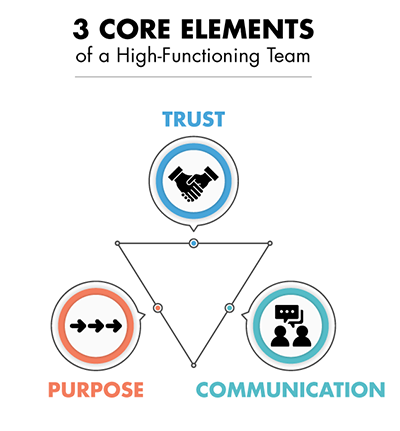Take Your Team Leadership to the Next Level: 3 Core Elements to a High-Functioning Team
Take a moment to think about the best team that you have been part of. What made this such a great team? Over the past five years, FMI has spent considerable time studying the nuances of teams. Recent data, surveying over 400 senior leadership team members, indicates that team trust, shared purpose and communication are the top three predictors of team effectiveness. If you can increase these three core elements of a team, you will be more likely to inspire your team to achieve its goals.

Trust
Our data indicates that team trust is the best predictor of team performance. As leaders, we need to understand how to build team trust.
How to Increase Your Team Trust:
- Be Authentic. Being authentic will allow you to cultivate more genuine relationships with other members of your team. Say only what you mean. Admit your fears and mistakes. Be sincere in your passions and interests. Get to know your team in a more meaningful way. One practical way to do this is to kick off your next meeting with a nonwork-related question to get teammates to open up to one another. (Good rule of thumb – the leader goes first! You set the tone for the rest of the group to feel safe in sharing meaningful experiences.)
- Be Empathetic. To be empathetic takes time and energy. This can be challenging when we are leading busy work lives with multiple competing demands. The next time you have an opportunity to engage with your team but find yourself rushing to check off items on your to-do list instead, try to remind yourself to pause. Put away those distractions. Truly listen. Consider the perspectives of others and connect with them.
- Be Reliable. While cultivating authenticity and empathy is paramount in building trust, it is also futile without follow-through. To build and maintain your team’s trust, you must show up on time, be prepared, consistently deliver quality work, and have enough expertise to further the team’s objectives. Doing these things consistently is critical to building trust on your team.
Purpose
While it’s important to be on a team with people you enjoy and trust, you need to be clear on why you’re gathered there in the first place. Without a shared purpose, teams lack clear direction and may spend time, energy and resources going down the wrong path. This can be frustrating and demotivating to team members.
How to Clarify Your Shared Purpose:
- Examine Your “Why.” It is often shocking to recognize how many teams are formed without a clear reason for why they exist. Because of this reality, it is imperative that you take a step back and ensure that there is a meaningful purpose for your team. What is your team’s vision for the future? Do all team members understand that and how they fit into it?
- Clarify Your Objectives. Once you obtain joint agreement on what your end goal is, you must then agree as a team on how you will get there. Having alignment on team objectives allows everyone to move in the same direction toward achieving those goals. Your team’s objectives should be clear and actionable, while also relating directly to your shared purpose. For example, if your team’s purpose is to explore options for entering a new strategic market, you might set objectives to: collect current market data; align key, organizational stakeholders; and scenario plan for multiple outcomes. Whatever those objectives for your team are, it is critical that all team members are aligned and committed to achieving them.
Communication
We all know the saying “communication is key,” and our data indicates that this continues to be true, especially for leadership teams within the construction industry.
How to Improve Your Team Communication:
- Communicate Face-To-Face. When 93% of our communication is communicated through nonverbal means (i.e., tone and body language)1, we lose a lot when we don’t communicate face-to-face. While modern communication methods (e.g., email, text, call and Skype) are undoubtedly convenient, they may be derailing team effectiveness. Too many assumptions can be made when we lose the ability to read our team members’ body language. For this reason, set a goal to meet face-to-face at regular intervals, whether weekly, monthly or quarterly. When face-to-face isn’t an option, incorporating video provides another way to connect beyond a phone call.
- Involve Each Team Member. As you consider your team dynamics, do one or two people consistently dominate the conversation? Do some team members rarely speak up at all? To fully utilize all team members’ expertise, each person should feel comfortable and encouraged to weigh-in and provide an opinion or idea. As a team leader, look for opportunities to call on individuals whoi. may not have had the opportunity to speak or have their opinions voiced during the meeting.
Trust. Purpose. Communication. These are the hallmarks of a high-functioning team. Do you know where your team is strong or still needs work? Test out one of these suggestions to improve your team’s trust, clarity of purpose or communication.
1 Mehrabian, Albert. Silent messages. Vol. 8. Belmont, CA: Wadsworth, 1971.
.png)


